I am a self-professed Sauerkraut Maniac. I love sauerkraut. Which is pretty ironic considering my first experience with sauerkraut came in early elementary school and I opted to take no recess over eating boiled-to-death putrid-smelling “sauerkraut” for school lunch. I spent the next 40 years despising the stuff.
Fast forward to a few years ago when I decided I needed to put my son on the Gut and Psychology Syndrome Diet (GAPS ). The GAPS Diet has an emphasis on lacto-fermentation, REAL lacto-fermented foods like great-great-grandma used to make. Six months after starting GAPS, I decided it was time to take the plunge into fermentation. You will also find lacto-fermentation as a foundation in other healing diets such as Body Ecology, the Specific Carbohydrate Diet (SCD). Dr. Zach Bush, the creator of Restore which is a supplement that helps heal the tight junctures of the intestinal lining, specifically recommends sauerkraut to help repopulate the gut with a diverse population of good bacteria.
Why sauerkraut? Because homemade sauerkraut is bursting with Vitamins C and K and has an astonishing amount of probiotics per serving. Two ounces of home-fermented sauerkraut had more probiotics than a bottle of 100 count probiotic capsules. Translated, this means a mere 16 ounces of sauerkraut can pack the punch of eight bottles of probiotics. You can read more about the nutrition side of sauerkraut at the blog Nourishing Plot.
I was scared at first because purposely “turning” food and feeding it to people seemed really, really wrong. I mean, what if I poison them?! But fermentation is not spoiling or rotting. It’s all about preserving. I faced my fear and took the plunge with the help of some very cool fermentation jars from Pickl-It. I have been known to refer to them as “Fermentation for Dummies” jars because it’s really hard to mess up a ferment in these jars.
One note on histamines: if you have issues with high histamine foods, you may not be able to tolerate sauerkraut. That is a judgment you will need to make for yourself!
But my enthusiasm alone for kraut isn’t enough to convince people to make it for themselves. Local folks get a sample of my kraut, and they still are not confident to try it for themselves. So here is my attempt to walk you through the process in the hopes that you will decide to make this amazing healing super food for yourself and your family. Following is a step by step guide on how I make my kraut.
Materials Needed:
- 2 medium to large heads of cabbage
- Large bowl
- Knife and cutting board
- Salt
- Filtered water
- Fermentation jar or crock
- Weights for keeping cabbage below brine line
Instructions:
- Quarter the heads of cabbage and cut out the core. Slice the cabbage as thinly as possible.
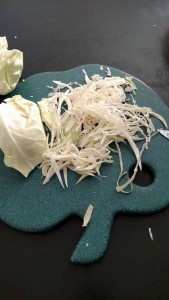
- Layer the sliced cabbage and salt in the bowl. I used about 38 grams of salt for this much cabbage, and the salt I used is finely ground so that it dissolves easily. Use Celtic sea salt or Himalyan salt, not iodized table salt.
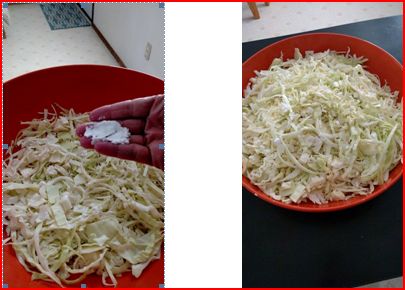 Once you have all of the layers complete, you will massage/squeeze/crunch the cabbage for FIVE MINUTES. This breaks down the fibers of the cabbage and releases the enzymes that are necessary for fermentation. It will reduce the size of the cabbage by about half, and it will release liquid, which is the beginning of your brine. Warning: Your forearms will be screaming to stop so make sure you set a timer! This is also the time where I put positive and loving intentions into my kraut. I thank the cabbage for its nourishment, and I send it thoughts and vibrations of love.
Once you have all of the layers complete, you will massage/squeeze/crunch the cabbage for FIVE MINUTES. This breaks down the fibers of the cabbage and releases the enzymes that are necessary for fermentation. It will reduce the size of the cabbage by about half, and it will release liquid, which is the beginning of your brine. Warning: Your forearms will be screaming to stop so make sure you set a timer! This is also the time where I put positive and loving intentions into my kraut. I thank the cabbage for its nourishment, and I send it thoughts and vibrations of love.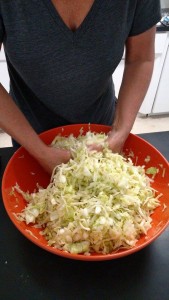 After five minutes, form the cabbage into a loaf shape in the bowl. Cover this and leave for at least eight hours or overnight. I place a small bowl between the cabbage and the towel to avoid any loss of moisture into the towel. I like to leave it overnight because then I don’t have to keep track of time.
After five minutes, form the cabbage into a loaf shape in the bowl. Cover this and leave for at least eight hours or overnight. I place a small bowl between the cabbage and the towel to avoid any loss of moisture into the towel. I like to leave it overnight because then I don’t have to keep track of time.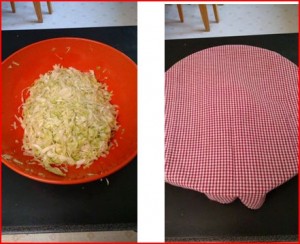 Move the cabbage and brine into the fermentation vessel. Pack the cabbage down firmly but not super tight. Add filtered water if needed so the brine line is about one inch over the cabbage and is at the “shoulder” of the jar. Place weights on top to keep the cabbage below the brine line. The cabbage will have a tendency to rise up for a few days as the bubbles from below try to move up. Just check it periodically and push it back down if it’s crept up.
Move the cabbage and brine into the fermentation vessel. Pack the cabbage down firmly but not super tight. Add filtered water if needed so the brine line is about one inch over the cabbage and is at the “shoulder” of the jar. Place weights on top to keep the cabbage below the brine line. The cabbage will have a tendency to rise up for a few days as the bubbles from below try to move up. Just check it periodically and push it back down if it’s crept up.
- Let it sit at room temperature and in the dark, and wait for the magic to happen! like to ferment my cabbage for at least three weeks. The longer the ferment time, the tangier the taste. It’s completely up to you as to how long you should ferment. Once you’ve decided it’s done, remove from the fermenting vessel and place in jars or other glass storage. Keep in the refrigerator, and then eat.
~ Raven
For more by Raven, click here.
Raven image courtesy of Victor Habbick at FreeDigitalPhotos.net.








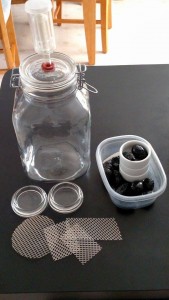
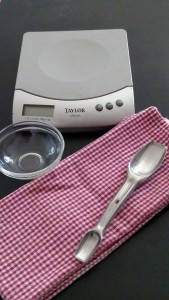
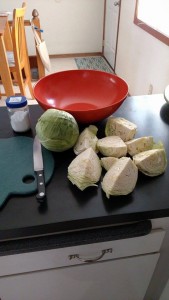
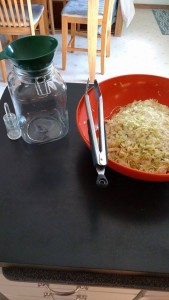
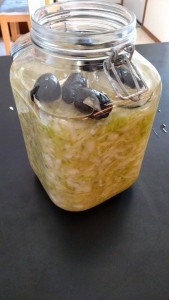

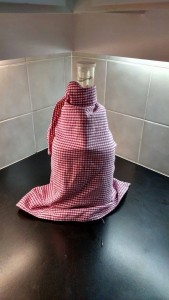










I’ve been making mine the German way for years http://earthlychow.com/the-easy-foolproof-way-to-make-your-own-probiotic-fermented-sauerkraut
I may finally be ready to make some on my own. When you move the sauerkraut from the ferment jar to other jars, do you pour liquid over it again, or just the fermented cabbage?
I’ve been buying non pasteurized from the stores. I use it now instead of lettuce on sandwiches. My favorite is roast beef (grass fed) on GF bread, with sauerkraut (probiotics) and raw havarti, with mustard (anti-inflammatory). It adds moistness to the gf bread and crunch the sandwich. Yum!
I usually have enough brine from the original big jar to go around in the other jars for storage. If by chance you don’t, then yes - just add some more filtered water but also pack the kraut down a bit before you add water because you’ll likely find that you won’t need to add much. The sauerkraut will continue to ferment in the fridge, just as a much slower rate. So any water you add will eventually turn into full-power brine!
I’ve heard of putting it on hotdogs but how else do you eat it?
Hi Krista - I eat it plain as a side dish or as a snack. Other options include mixing it with other vegetables or using it as a garnish for salads etc. It’s important to remember though to NOT heat the raw sauerkraut (as you would often find on hot dogs) because heat kills the good bacteria.
My son does not eat mushy foods so for him, I slip some sauerkraut (or other feremented vegetable) brine into his milk.
How long does this last in the fridge? Just curious..someone gave me some fermented veggies and I’m not sure how long they’re “fresh” in the fridge? Thanks for making this easy for us! I’m going to try!
Honestly, it will last months in the fridge but it’s still up to you to decide for each batch because conditions change and each batch is different. Just make sure that the brine line is above the cabbage. If you need to add a little water, that’s ok. Here’s a good article talking about how to determine if your ferments are still good: http://fermentationpodcast.com/how-long-sauerkraut-pickles-ferments-last/
As an FYI - I have pickles in my fridge that are a couple of years old and they are still amazing and crunchy. Thanks for the question and I’m happy that you’re going to try!